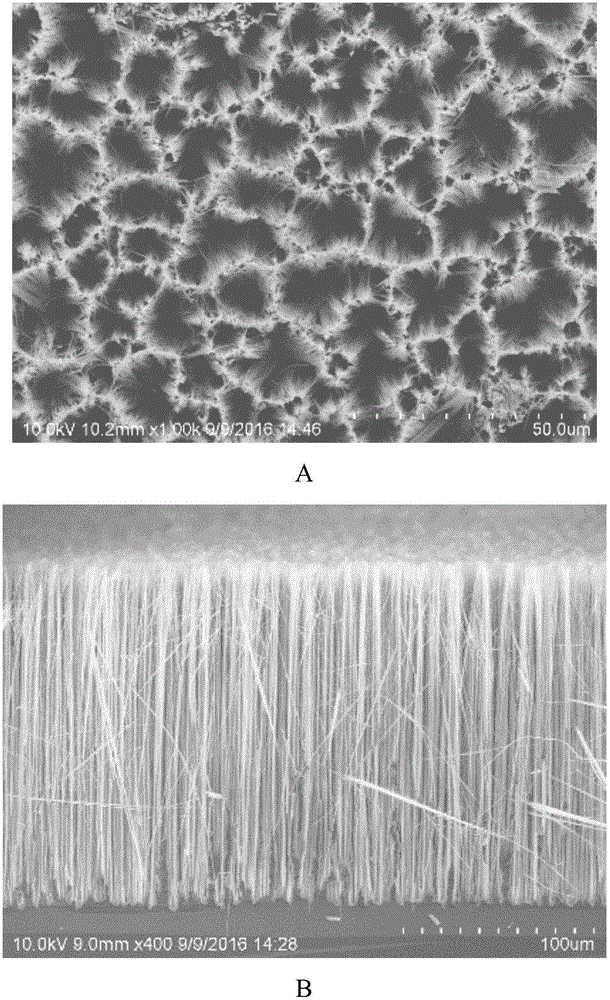Beta-galactosidase fluorescent sensor based on silicon nanowire as well as preparation method and application of beta-galactosidase fluorescent sensor
The technology of galactosidase and fluorescence sensor is applied in the field of nanostructured fluorescence chemical sensor, which can solve the problems of time-consuming and low covalent connection efficiency, and achieve the effects of saving time, less damage and simple preparation method.
- Summary
- Abstract
- Description
- Claims
- Application Information
AI Technical Summary
Problems solved by technology
Method used
Image
Examples
Embodiment 1
[0041] Example 1 Preparation method of a fluorescent sensor for detecting β-galactosidase based on a single silicon nanowire
[0042] A method for preparing a fluorescent sensor for detecting β-galactosidase based on a single silicon nanowire, comprising the following steps:
[0043] 1) At room temperature, silver oxide and p-hydroxybenzaldehyde were added to the acetonitrile solution of 2,3,4,6-tetraacetyl-α-D-pyranose bromide and stirred for 14 hours, filtered and purified to obtain product 1; Wherein, the molar ratio of silver oxide, p-hydroxybenzoic acid, and 2,3,4,6-tetraacetyl-α-D-pyranose bromide is 2:1:1.
[0044] 2) Dissolve the product 1 in step 1) in a mixed solution of chloroform and isopropanol (v / v=25 / 8), put it in an ice bath, add sodium borohydride in batches=stir at room temperature for 3 hours, Spot the plate to track the reaction, add 10% sodium citrate solution to quench the reaction, wash three times with 10% sodium bicarbonate solution, wash once with wa...
Embodiment 2
[0051] Example 2 Preparation method of a fluorescent sensor for detecting β-galactosidase based on a single silicon nanowire
[0052] A method for preparing a fluorescent sensor for detecting β-galactosidase based on a single silicon nanowire, comprising the following steps:
[0053] 1) At room temperature, silver oxide and p-hydroxybenzaldehyde were added to the acetonitrile solution of 2,3,4,6-tetraacetyl-α-D-pyranose bromide and stirred for 16 hours, filtered and purified to obtain product 1; Wherein, the molar ratio of silver oxide, p-hydroxybenzoic acid, and 2,3,4,6-tetraacetyl-α-D-pyranose bromide is 1:1:1.
[0054] 2) Dissolve the product 1 in step 1) in a mixed solution of chloroform and isopropanol (v / v=25 / 8), put it in an ice bath, add solid sodium borohydride in batches and stir at room temperature for 4 hours, Spot the plate to track the reaction, add 10% sodium citrate solution to quench the reaction, wash with 10% sodium bicarbonate solution three times, wash on...
Embodiment 3
[0061] Example 3 Preparation method of a fluorescent sensor for detecting β-galactosidase based on a single silicon nanowire
[0062] A method for preparing a fluorescent sensor for detecting β-galactosidase based on a single silicon nanowire, comprising the following steps:
[0063] 1) At room temperature, silver oxide and p-hydroxybenzaldehyde were added to the acetonitrile solution of 2,3,4,6-tetraacetyl-α-D-pyranose bromide and stirred for 18 hours, filtered and purified to obtain product 1; Wherein, the molar ratio of silver oxide, p-hydroxybenzoic acid, and 2,3,4,6-tetraacetyl-α-D-pyranose bromide is 2:1:2.
[0064] 2) Dissolve the product 1 in step 1 in a mixed solution of methyl chloride and isopropanol (v / v=25 / 8), put it in an ice bath, add sodium borohydride in batches and stir at room temperature for 5 hours, spot the plate Follow up the reaction, add 10% sodium citrate solution to quench the reaction, wash three times with 10% sodium bicarbonate solution, wash onc...
PUM
 Login to View More
Login to View More Abstract
Description
Claims
Application Information
 Login to View More
Login to View More - R&D
- Intellectual Property
- Life Sciences
- Materials
- Tech Scout
- Unparalleled Data Quality
- Higher Quality Content
- 60% Fewer Hallucinations
Browse by: Latest US Patents, China's latest patents, Technical Efficacy Thesaurus, Application Domain, Technology Topic, Popular Technical Reports.
© 2025 PatSnap. All rights reserved.Legal|Privacy policy|Modern Slavery Act Transparency Statement|Sitemap|About US| Contact US: help@patsnap.com



